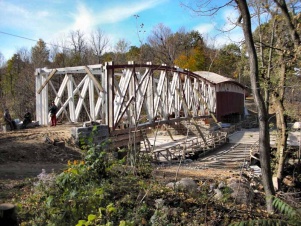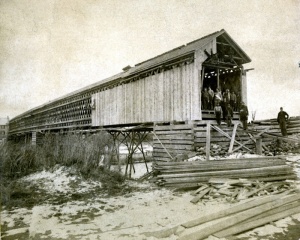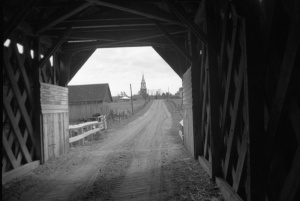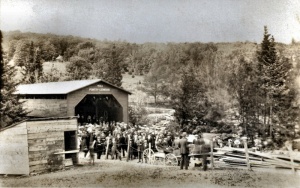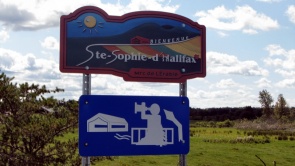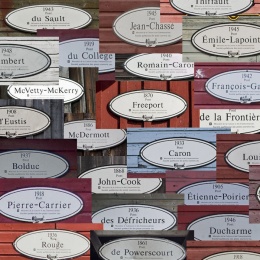Covered Bridges of Quebec
par Arbour, Gérald
From the early 18th and up to the middle of the 19th century, hundreds of wooden covered bridges were built in Quebec. These structures, which were a common sight in the country side over the last century, have been witness to much of the province's economic and political history. The systematic construction of these distinctly designed bridges is a phenomenon that is being studied more and more. Replaced in great numbers when the road network was improved in the 1950s and 1960s, less than a hundred of the structures now remain. Today they are an essential part of Quebec's architectural heritage.
Article disponible en français : Ponts couverts au Québec
The Early Days
Since the early days of New France, wood was the material of choice for Quebec's forefathers, who had to clear the forest in order to create the necessary space for permanent settlements. An obstacle at first, the forest became an asset and is at the core of one of the industries that profoundly shaped Quebec. One must remember that the royalties the logging industry paid to the State were the first income registered in the government's budget that ensured the development of the province. Over time, wood would gradually replace stone as the basic construction material for buildings.
Even if the forest is seemingly vast and endless, the number of water courses that obstruct those travelling through it are also profuse. A few pieces of wood thrown across a small river do the trick for a time, but given that there was a time when cement and steel was not easy to come by in many a region of North America, builders would naturally turn tousing wood to build the first real bridges.
A Complex Technology
Protecting a bridge using a roof was technique that had already been in existence for centuries, when the first Europeans set foot in North America. There were already covered bridges in Europe and Asia and some very ancient ones still stand today. Thus, carpenters were familiarwith the technology used to erect such reliable and lasting structures. But in Quebec, the European influences would eventually come to be mixed with American influences. And so, it was from south of the boarder that the first models of covered bridges were imported in the 19th century, in order to extend the road network that expanded further and further inland.
Of all the most famous American bridge builders whose work has been reproduced here, there are a few worth mentioning: William Howe, Daniel Craig McCallum and most importantly, Ithiel Town of Thompson, Connecticut. The latter's lattice truss bridge became the most common style to be used in the Province of Quebec. These popular trusses were used for road and train bridges, but rarely as foot bridges, contrarily to China, where covered bridges were mostly reserved for pedestrians, in addition to being used as a communal meeting place.
Despite the different types of bridges available, Quebec's builders quickly adopted the lattice truss patented by Ithiel Town in 1820. This construction style, which initially seems frail when compared to other existing models, is easy to build and requires little if any engineering calculations. Thus, the most of the labour could be carried by local, unskilled workers. Another significant advantage was that the lattice truss was an ideal choice for bridges requiring many spans, since the truss was designed as a continuous structure, and so there was no need for making any adjustments at each pier. The original Town model was adapted to the practical reality of rural areas, and so it quickly became the most typical kind of covered bridge to be used in the Quebec countryside. A final characteristic of these Town-style bridges is the stain made of red pigment mixed with linen oil, which was used to preserve the bridges. This distinctive feature quickly became synonymous with the covered bridge and took root in the vocabulary of the populace so completely that "covered bridge" and "red bridge" [Fr: pont rouge] almost came to mean the same thing.
The Town-style of the covered bridge was used almost exclusively very early on. This had the effect of preventing any new locally designed truss styles from emerging in Quebec. Moreover, as most bridges were constructed under the supervision of the government and local municipalities, this ensured that no specialized bridge-building companies would be founded that would have created their own style which would still be visible in some regions.
These bridges were not built to be used as a shelter against the elements or as private meeting places for lovers, although there are some interesting stories about this in the folklore! The reason for the roof is much more practical: it was to protect the bridge from the endless cycle of rain, snow and sun, the elements being among the worst enemies of exposed wood. An unprotected wooden bridge would generally have to be rebuilt after only 15 to 20 years of use. Our ancestors were thus quick to understand it was preferable to protect their investments by covering the whole construction with a roof and side panelling. The bridge's worn-out deck or roof could easily be replaced without having to change the superstructure - the most expensive part. Designed at a time when animals were the only means of transportation, the wooden covered bridges were well adapted to this type of transportation. The width was calculated with the size of a hay wagon in mindand it was sufficient sturdy to support the weight of such traffic-as well as the first cars that ventured on region's the roads.
The First Covered Bridges in Quebec
The earliest reference to a covered bridge indicates that it would have been built in Île-des-Moulins, near Terrebonne. According to a notary's records (NOTE 1), written by François-Hyacinthe Séguin in Sepbermber of 1812, it was a matter of "refurbishing the bridge, which is south of the afore mentioned mills that links the public square to the islet, in the same style as original bridge for the sum of 2,400 pounds". This second (refurbished )bridge is described in 1833 by the architect John Atkinson in a catalogue of the buildings erected at Île-des-Moulins. He speaks of "[...] a wooden bridge built of stone and covered with shingles" (NOTE 2). The structure measured 42.5 metres [140 feet] long.
Archives from later years mention other structures built by the Département des Travaux Publics du Bas-Canada [Lower Canada Department of Public Works], a government office that would eventually be responsible for major public works projects such the Batiscan Bridge in 1844. 378 metres [1,240 feet] long, it is the longest covered bridge ever built in Quebec. Records of covered bridges erected by private companies (toll-bridges) or for the railway system would later appear in the archives of the 19th century, as the effects of the industrial revolution began to be felt in the province. But, it is in 1888, with the creation of the Quebec Département de la Colonisation [Land Settlement Office] and the government's growing commitment to the development of public roads, that covered bridges started to be built en mass. Hundreds of bridges of this type would eventually be built all across Quebec during the following decades. The picturesque structures would be witness to many changes over the years as the Province of Quebec grew and developed. For example, the Powerscourt Bridge, one of the worlds most unique covered bridges and the oldest in Canada, is closely linked to the history of the railway system's. As for the Abitibi region's covered bridges (among the last ever built) they were constructed as a part of the northward expansion movement that settled the region. Many others, built all across the province, were constructed as a strategy to counter the devastating effects of the unemployment caused by the Great Depression. In addition to the more official references to the covered bridge there are surely many a local tale to be told involving these quaint structures.
Rise and Fall of Covered Bridges
With the passing of the years, the road network continued to develop and people moved ever further inland. Passable roads were needed to link the various population centers and ensure the free flow of goods on which the local economies depended. During the 19th century, the majority of bridges were built of wood, but not all were covered. The imposing heavy metal or concrete constructions were more the exception than the rule.
The construction of wooden covered bridges was a political choice that illustrated a socio-economic reality. In Quebec, over a thousand covered bridges were built over a period of a century and a half. New Brunswick comes in second with around 400 covered bridges. They were built using a different design than those built in Quebec. Ontario constructed less then ten bridges of this kind and there are less than five in all the Western provinces put together.
During the latter years of the covered bridge era, the wooden bridges generally grew in size and weight-and covered bridges in particular. This made them the weakest link a road network that people had come to depend heavily on and needed to be reliable as possible. As a result, the bridges required maintenance all year long. As early as the late 1950s, it became evident that the use of wood was outdated. Quebec's last covered bridges were built during these years and eventually, they were replaced with increased rapidity as the "improved roadways" became a political necessity. Along with Oregon, Quebec remained, one of the regions in North America where bridges of this type were last built.
A Growing Awareness of the Covered Bridge's Heritage Value
In the frenzy that surrounded the time when modernism was on the rise everywhere, almost no one talked about the preservation of architectural heritage. And so, a great deal of covered bridges were demolished. When locals grew tired of waiting for road improvements, suspicious fires were sometimes used as a way to speed up the construction of a new bridge-after all, it was considered to be rather embarrassing to have an old wooden covered bridge that led to one's village while in the neighbouring county new concrete bridges were being built.
Despite the great number of red bridges built inQuebec, today only 84 remain in their original location, which is less than 10% overall. And these remaining structures are not invulnerable, for the current situation might see their numbers reduced even more. First of all, they can be found in various states of preservation. Second, these historic bridges are used much more often now than when they were built. Thus, the maintenance periods must be more frequent and closer together.
In 1981, a non-profit organisation dedicated to the promotion and preservation of Quebec's covered bridges was created. Over a period of about 20 years, this Société Québécoises des Ponts Coverts (SQPC) has devoted itself to making people aware of the necessity of preserving piece of the province's architectural heritage. Over the years, a great deal of documents have been published in Le Pont'âge (NOTE3), the quarterly newsletter of the SQPC. The positive effects of the work of these aficionados is still having its effect today. With more than 300 members, the SQPC was dissolved in 2002, victim of its own success.
That same year, the government of Quebec started to take concrete measures in favour of preserving covered bridges. In fact, heritage classification and listing (NOTE 4) are the main ways in which they are given some form of official recognition that usually results in raising enough interest towards preserving them. Although municipalities are the real owners of these structures, in 2002, the Ministère des Transports du Québec established a standard method for calculating the heritage value of each of the covered bridges in the network. Three years later, the same ministry adopted a policy for identifying and managing bridges determined to have heritage value. This includes bridges of various types. This policy is what specifies exactly what kind of measures should be taken to preserve each bridge, given its heritage value
Witnesses of the Past to be Preserved for the Future
A covered bridge is a fascinating sight for visitors and, since it is usually located in an enchanting setting, it is also the delight of painters and photographers. But beyond such considerations, these now nearly obsolete structures are still useful and so they are kept in service inaccordance with modern criteria that are far from those present at the time of their construction. Today, the knowledge to restore them properly has almost vanished. Yet, more and more municipalities that own one or more of the red bridges make good use of these structure's uniquely attractive heritage value. No longer an embarrassment to the community they are now the pride and joy of the local citizenry. Logos, coats of arms or interpretative panels are concrete visual reminders that ensure that past achievements continue to be recognised by future generations.
Gérald Arbour
Former president of the Société Québécoise des Ponts Couverts
[Quebec Covered Bridge Society]
NOTES
Note 1. Bibliothèque et Archives Nationales du Québec, Répertoire du notaire François-Hyacinthe Séguin (1808-1847) 1977, 2v., 220 pages. Reference code: CN606,S27
Note 2. Gauthier Larouche, Georges, L'Île-des-Moulins, Terrebonne. Un Ensemble à Restaurer. Ministère des Affaires Culturelles, Service des Monuments Historiques, 1976.
Note 3. The complete edition of Pont'âge has a total of about 800 pages and is kept at the Bibliothèque et Archives Nationales.
Note 4. Classification by the Government of Quebec. Listed by local municipalities.
BIBLIOGRAPHY
Arbour, Gérald. Les ponts durables, Édition privée, 2009.
Arbour, Gérald, Jean-Marie Beaujean, Joseph Conwill et Gaétan Forest, Les ponts rouges du Québec, Société québécoise des ponts couverts, 1999.
Arbour, Gérald, Fernand Caron et Jean Lefrançois, Lesponts couverts au Québec, Les Publications du Québec, 2005.
Clusiau, Éric, Des toits sur nos rivières, les ponts couverts de l'Est du Canada, Éditions Hurtubise HMH, 2000.
Gillis ,Stephen & John Gillis, No faster than a walk, the covered bridges of New Brunswick, Goose Lane Editions, 1988.
L'Île-des-Moulins, ministère des Affaires culturelles, Direction générale du patrimoine, 1979.
Orientation ministérielle sur l'identification et lagestion des ponts à valeur patrimoniale, Transports Québec, 2005.
Additional DocumentsSome documents require an additional plugin to be consulted
Images
-
 Affiche pour une fête
Affiche pour une fête
au pont couver... -
 Enveloppe
Enveloppe
-
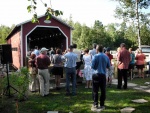 L'inauguration du pon
L'inauguration du pon
t couvert du Co... -
 La Trinité-des-Monts,
La Trinité-des-Monts,
rivière Rimous...
-
 Le pont couvert du Fa
Le pont couvert du Fa
ubourg à L'Anse... -
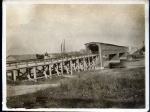 Le pont jeté au-dessu
Le pont jeté au-dessu
s de la rivière... -
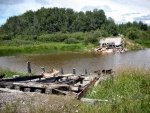 Ruisseau du Panache,
Ruisseau du Panache,
Saint-Félix-de-... -
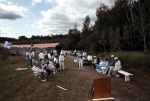 Une fête au pont McVe
Une fête au pont McVe
tty-McKerry de ...

